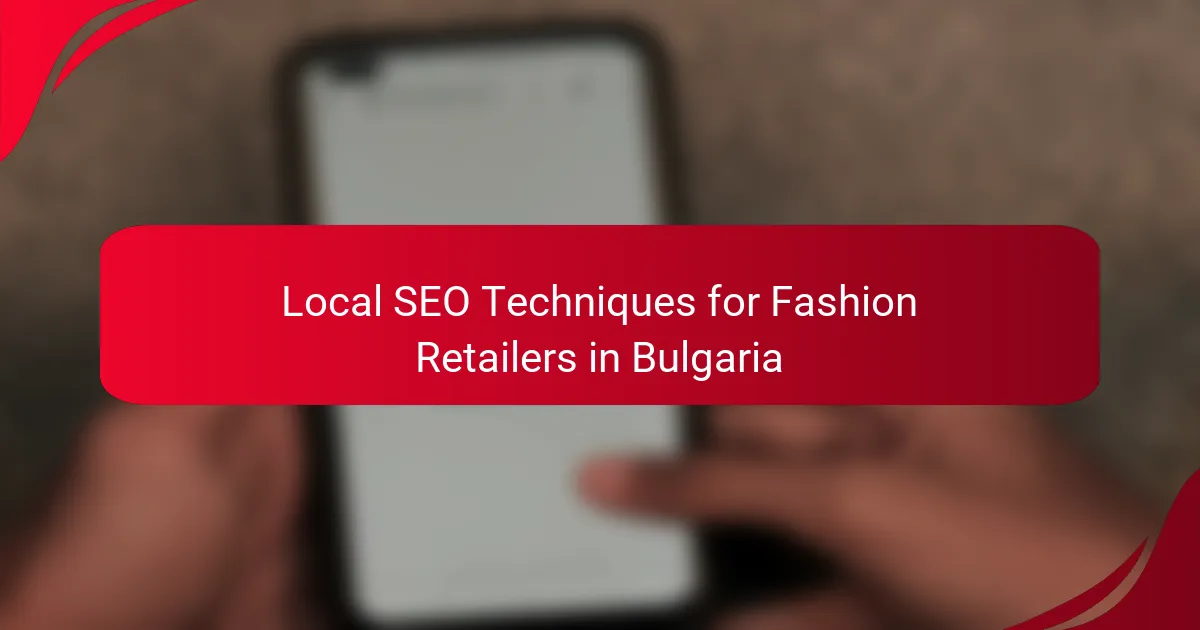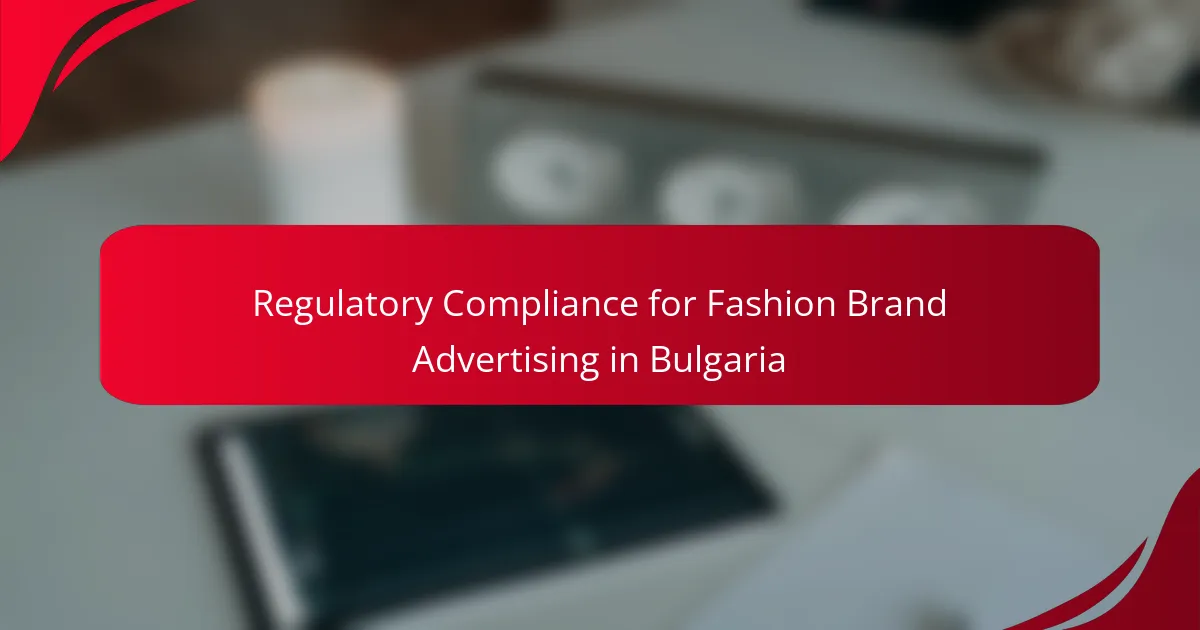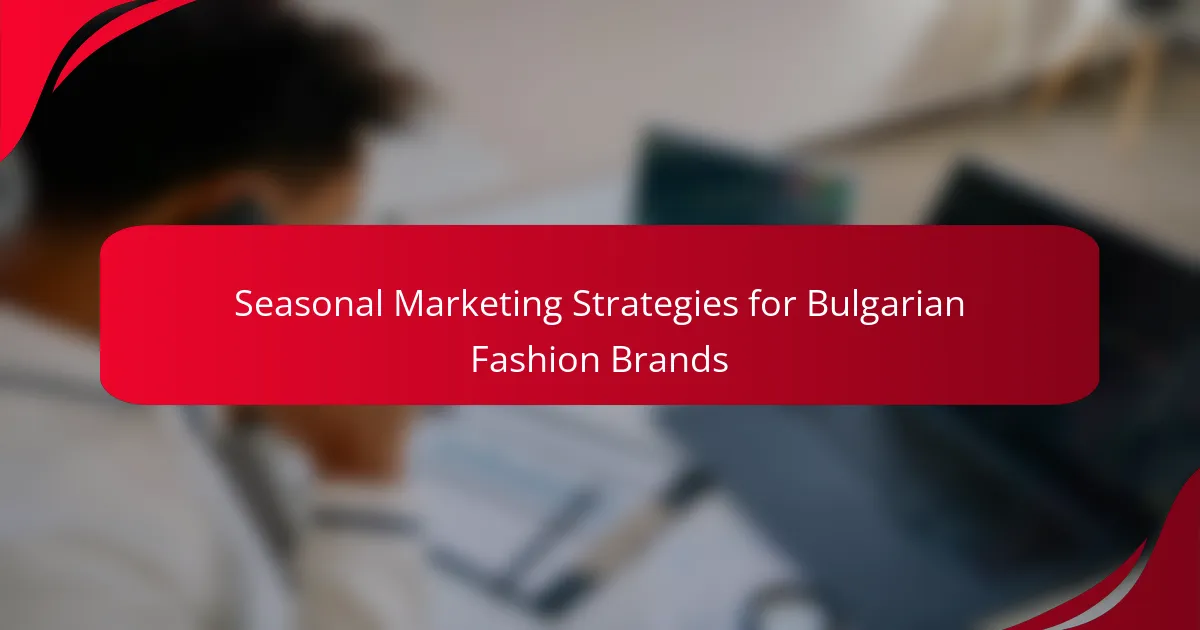Influencer marketing presents a valuable opportunity for fashion brands in Bulgaria to enhance their visibility and engage with consumers. By fostering authentic relationships with local influencers and creating tailored content, brands can effectively connect with their target audience. Utilizing influencer marketing platforms and analyzing demographics can help identify the right influencers, ensuring alignment with the unique characteristics of the Bulgarian market.
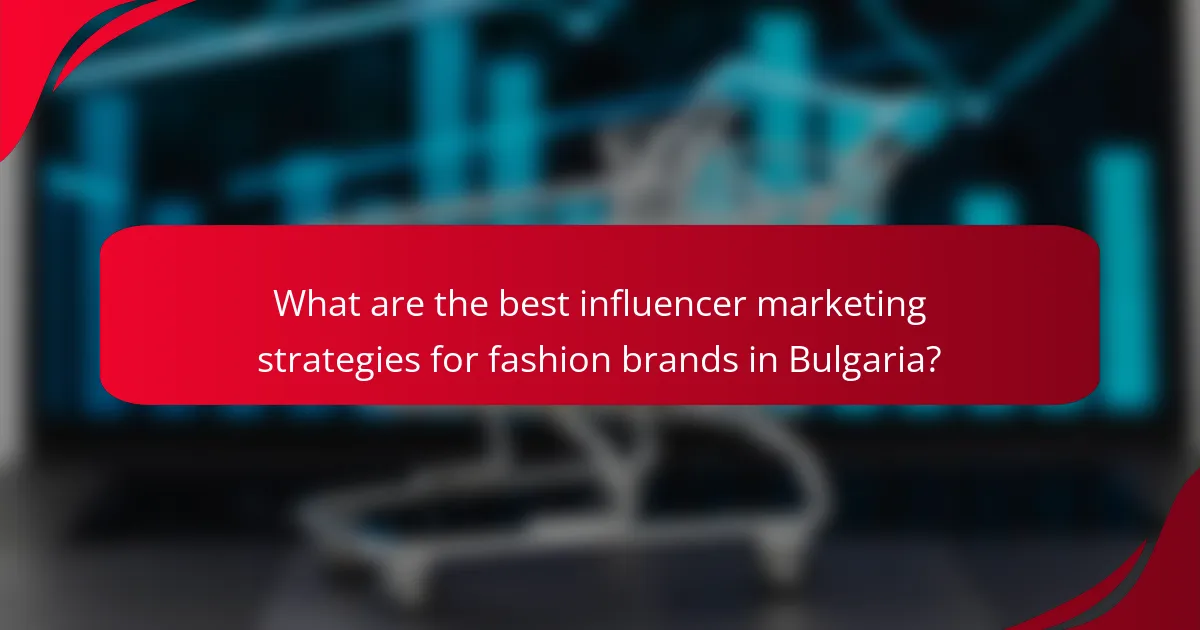
What are the best influencer marketing strategies for fashion brands in Bulgaria?
The best influencer marketing strategies for fashion brands in Bulgaria focus on building authentic relationships with local influencers and leveraging popular social media platforms. Brands should create engaging content that resonates with their target audience while considering the unique characteristics of the Bulgarian market.
Collaborations with local fashion influencers
Partnering with local fashion influencers can significantly enhance a brand’s visibility and credibility in Bulgaria. These influencers often have a dedicated following that trusts their recommendations, making them ideal for promoting fashion products.
When collaborating, brands should ensure that the influencer’s style aligns with their own. This alignment helps maintain authenticity and ensures that the promotional content feels natural to the audience.
Utilizing social media platforms like Instagram
Instagram is a key platform for fashion brands in Bulgaria, as it allows for visually appealing content that showcases products effectively. Brands should focus on creating high-quality images and videos that highlight their clothing and accessories.
Engagement on Instagram can be boosted through interactive features like polls, stories, and live sessions. These tools help brands connect with their audience and encourage user-generated content, further enhancing brand loyalty.
Creating engaging content for campaigns
Engaging content is crucial for successful influencer marketing campaigns. Brands should focus on storytelling that resonates with their audience, showcasing not just the products but also the lifestyle associated with them.
Incorporating user-generated content can enhance engagement, as it encourages followers to share their experiences with the brand. This approach not only builds community but also provides authentic testimonials that can influence potential customers.
Leveraging micro-influencers for niche markets
Micro-influencers, who typically have smaller but highly engaged followings, can be particularly effective for targeting niche markets in Bulgaria. These influencers often have a strong connection with their audience, leading to higher engagement rates.
Brands should consider working with multiple micro-influencers to reach diverse segments of the market. This strategy can be more cost-effective than partnering with a single high-profile influencer, while still achieving significant reach and impact.

How can fashion brands identify suitable influencers in Bulgaria?
Fashion brands in Bulgaria can identify suitable influencers by leveraging various tools and strategies that focus on audience alignment and engagement. This involves utilizing influencer marketing platforms, analyzing demographics, and researching local fashion events to find influencers who resonate with their target market.
Using influencer marketing platforms like Upfluence
Influencer marketing platforms such as Upfluence provide valuable resources for fashion brands to discover and connect with suitable influencers in Bulgaria. These platforms allow brands to filter influencers based on specific criteria, such as follower count, engagement rates, and niche relevance.
Utilizing these tools can streamline the selection process, enabling brands to efficiently identify influencers who align with their brand values and target audience. Additionally, many platforms offer analytics features to track campaign performance and ROI.
Analyzing audience demographics and engagement rates
Understanding audience demographics and engagement rates is crucial for fashion brands when selecting influencers. Brands should look for influencers whose followers match their target customer profile in terms of age, gender, and interests.
Engagement rates are equally important; a smaller influencer with high engagement may be more effective than a larger influencer with low interaction. Brands can use tools to analyze these metrics, ensuring they choose influencers who can genuinely connect with their audience.
Researching local fashion events and influencers
Researching local fashion events in Bulgaria can uncover influencers who are actively involved in the industry. Attending events like fashion shows or exhibitions allows brands to network and identify influencers who are passionate about fashion and have a strong local presence.
Brands can also follow social media conversations around these events to spot trending influencers. Engaging with local influencers who participate in these events can enhance brand visibility and credibility within the Bulgarian fashion scene.
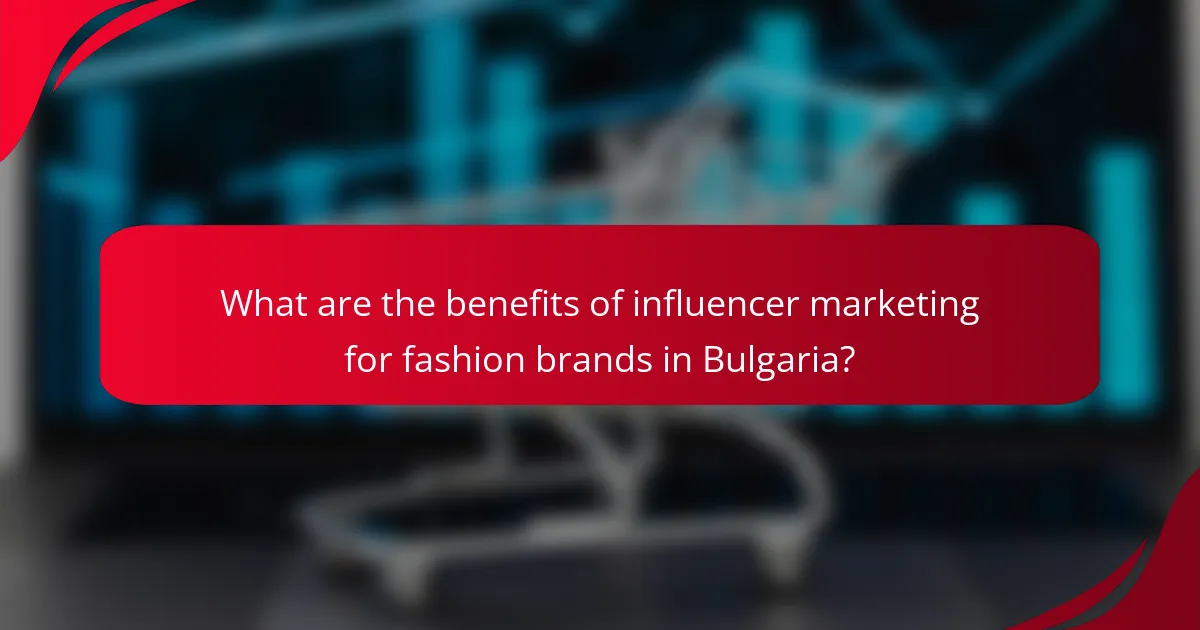
What are the benefits of influencer marketing for fashion brands in Bulgaria?
Influencer marketing offers significant advantages for fashion brands in Bulgaria, including increased visibility and consumer engagement. By collaborating with local influencers, brands can effectively reach their target audiences and build a loyal customer base.
Increased brand awareness among target audiences
Influencer marketing can dramatically enhance brand awareness for fashion labels in Bulgaria. By partnering with influencers who resonate with specific demographics, brands can tap into established follower bases, amplifying their reach significantly.
For instance, a Bulgarian fashion brand might collaborate with a popular local influencer on social media platforms like Instagram or TikTok. This collaboration can result in thousands of impressions, introducing the brand to potential customers who may not have been aware of it previously.
Enhanced consumer trust through authentic endorsements
Authenticity is crucial in building consumer trust, and influencers often provide that through genuine endorsements. When a trusted influencer shares their positive experience with a fashion brand, their followers are more likely to perceive the brand as credible and reliable.
For example, if an influencer showcases a clothing line and shares their honest opinion about the quality and fit, their audience is more inclined to trust that recommendation over traditional advertising methods. This trust can lead to increased sales and brand loyalty.
Higher engagement rates compared to traditional advertising
Engagement rates for influencer marketing campaigns typically surpass those of traditional advertising methods. Influencers create content that resonates with their followers, leading to higher interaction levels, such as likes, comments, and shares.
In Bulgaria, fashion brands can expect engagement rates of around 3-10% on influencer posts, compared to lower rates for standard ads. This higher engagement not only boosts visibility but also fosters a sense of community around the brand.

What challenges do fashion brands face in influencer marketing in Bulgaria?
Fashion brands in Bulgaria encounter several challenges in influencer marketing, including the difficulty of identifying authentic influencers, understanding cultural nuances, and managing budget constraints. These factors can significantly impact the effectiveness of marketing campaigns and brand reputation.
Identifying genuine influencers versus fake followers
One of the primary challenges for fashion brands is distinguishing between genuine influencers and those with inflated follower counts due to fake accounts. Brands should analyze engagement rates, content quality, and audience demographics to ensure they collaborate with authentic influencers who resonate with their target market.
Tools like social media analytics platforms can help brands assess influencer credibility. Look for influencers with a high engagement rate relative to their follower count, as this often indicates a more genuine audience. Avoid influencers with suspiciously rapid follower growth or low interaction on posts.
Navigating cultural differences in marketing approaches
Cultural differences can influence how marketing messages are received in Bulgaria. Brands must tailor their campaigns to align with local values, trends, and consumer behavior. Understanding local fashion preferences and social norms is crucial for creating relatable content.
For example, Bulgarian consumers may respond better to influencers who incorporate traditional elements or local styles into their fashion choices. Collaborating with local influencers who understand these nuances can enhance brand authenticity and appeal.
Budget constraints for smaller brands
Smaller fashion brands often face budget limitations that restrict their ability to engage high-profile influencers. It is essential for these brands to explore cost-effective strategies, such as partnering with micro-influencers who typically have lower fees and more engaged audiences.
Brands can also consider negotiating performance-based compensation models, where influencers receive payment based on the success of their campaigns. This approach can help manage costs while still achieving impactful marketing results.
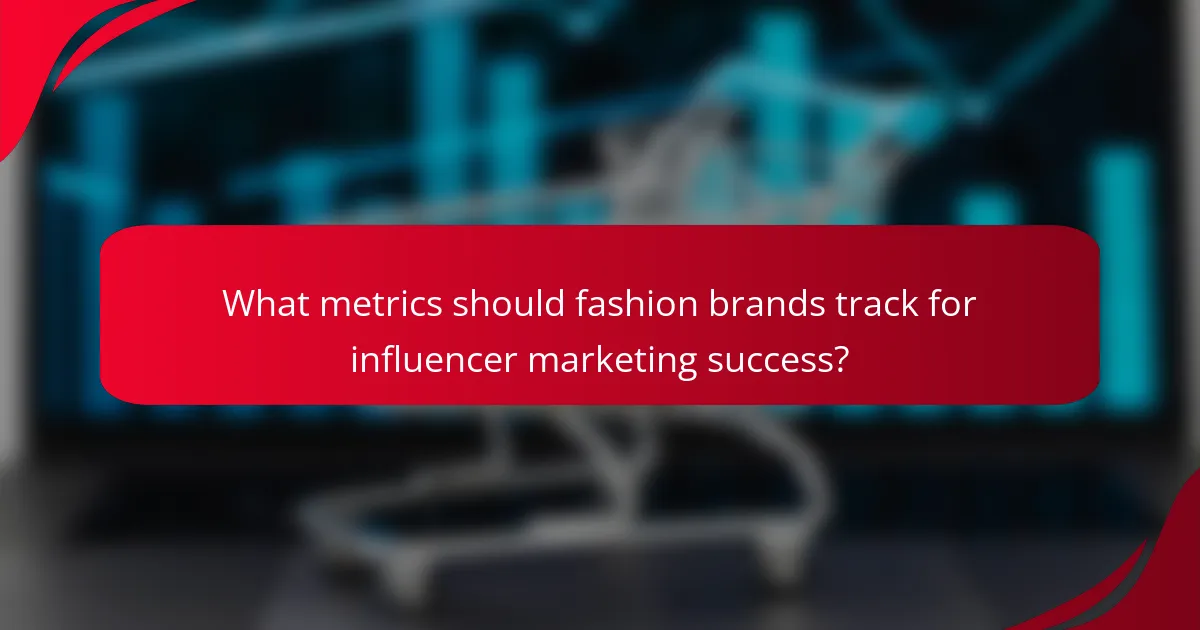
What metrics should fashion brands track for influencer marketing success?
Fashion brands should focus on several key metrics to gauge the success of their influencer marketing efforts. Tracking engagement rates, return on investment (ROI), and growth in follower counts and website traffic provides a comprehensive view of campaign effectiveness.
Engagement rates on social media posts
Engagement rates are crucial for understanding how well an influencer’s audience interacts with content. This metric typically includes likes, comments, shares, and saves, and is often expressed as a percentage of total followers. For fashion brands, a good engagement rate generally falls between 1% to 5%, with higher rates indicating stronger audience connection.
To calculate engagement rates, divide the total interactions by the number of followers and multiply by 100. Monitoring these rates helps brands identify which influencers resonate best with their target audience, allowing for more strategic partnerships.
Return on investment (ROI) from campaigns
ROI measures the profitability of influencer marketing campaigns, helping brands assess whether their spending is justified. To calculate ROI, subtract the total campaign cost from the revenue generated, then divide by the campaign cost and multiply by 100 to get a percentage. A positive ROI indicates successful investment.
Fashion brands should aim for an ROI of at least 2:1, meaning for every BGN spent, they should earn at least BGN 2 in return. Regularly analyzing ROI helps brands refine their strategies and allocate budgets more effectively.
Growth in follower counts and website traffic
Tracking the growth in follower counts and website traffic is essential for evaluating the impact of influencer partnerships. An increase in followers can indicate heightened brand awareness, while a boost in website traffic suggests successful conversion efforts. Brands should monitor these metrics before and after campaigns to measure effectiveness.
For practical insights, fashion brands can use tools like Google Analytics to track website traffic and social media analytics to monitor follower growth. A consistent upward trend in these metrics signals that influencer marketing efforts are paying off and reaching the desired audience.

What are the emerging trends in influencer marketing for fashion brands?
Emerging trends in influencer marketing for fashion brands focus on authenticity, engagement, and innovative technologies. Brands are increasingly leveraging social media influencers to connect with consumers who value transparency and sustainability in their purchasing decisions.
Increased focus on sustainability and ethical fashion
Fashion brands are prioritizing sustainability and ethical practices in their influencer marketing strategies. Collaborating with influencers who advocate for eco-friendly products can enhance brand credibility and attract environmentally conscious consumers.
For instance, brands can partner with influencers who promote sustainable fashion choices, such as thrift shopping or using recycled materials. This approach not only aligns with consumer values but also encourages a shift towards more responsible consumption.
Integration of augmented reality in campaigns
Augmented reality (AR) is becoming a key tool in influencer marketing for fashion brands, allowing consumers to virtually try on products before purchasing. This technology enhances the shopping experience and can significantly reduce return rates.
Brands can collaborate with influencers to create AR experiences, such as virtual fitting rooms or interactive product showcases. This not only engages the audience but also provides a unique way to showcase the brand’s offerings, making the shopping experience more immersive and enjoyable.







